Publications
...now browsing by category
Tuesday, July 12th, 2011
by Kristen Minogue

Ali Kishwar, a volunteer tourist from Pakistan, navigates the muddy terrain across from SERC’s beaver pond with caution. (Credit: SERC)
For most people, summer vacation means stretching out on a beach in the South Pacific, touring the ruins of ancient Greece, or (for the more outdoors-inclined) hiking the Inca Trail in Peru. It does not usually entail wading through ankle-deep mud to measure the diameters of trees.
Paul Smith, a 63-year-old retired engineer, travelled to SERC all the way from the United Kingdom to do it. So did Ali Kishwar, a Pakistani doctorate student who took a break from studying medicinal plants at the University of Reading in Berkshire, also in the U.K. Smith and Kishwar joined a motley group of seven citizen scientists who paid to spend a week at SERC doing field work.
Click to continue »
Posted in Climate Change, Ecology, Publications, SERC Sites and Scenes | Comments Off on Grimy field work? Give it to the tourists.
Monday, April 25th, 2011
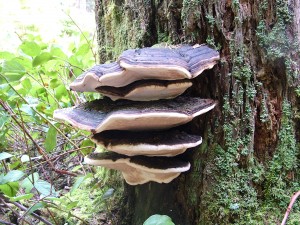
Research suggests some species in the tropics and subtropics may be more resistant to climate change than species closer to the poles. (Credit: SERC)
The threat of radical climate change has made predicting the future of biodiversity a critical challenge for scientists. However, untangling the many intricacies of how climate can affect plant and animal species can also be quite daunting. SERC ecologist Sean McMahon and co-authors, including three Nobel Laureates from the U.N. IPCC report, tackle the issue in a
paper published this month in
Trends in Ecology and Evolution. Broken down, here’s what we already know about biodiversity and climate, what we still need to know, and what to do next.
Click to continue »
Posted in Climate Change, Ecology, Publications | Comments Off on Climate Change & Biodiversity: What’s Next?
Friday, April 15th, 2011

A bacterium called Desulfovibrio desulfuricans strain ND132 can transform elemental mercury into methylmercury, a human neurotoxin. Credit: Oak Ridge National Laboratory.
A newly decoded bacterial genome brings scientists one step closer to unlocking the secret behind the production of methylmercury, the chemical notorious for contaminating tuna and other seafood.
Click to continue »
Posted in Publications | Comments Off on New Genome Helps Crack Methylmercury Code
Tags: Chesapeake Bay, Mercury, Microbiology, Pollution, Toxins
Friday, March 25th, 2011
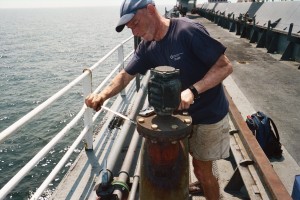
SERC researcher George Smith opens an air vent on the ship Patcantrell for a ballast water experiment. (Credit: Timothy Mullady/SERC)
The global economy depends on marine transportation. But in addition to cargo, the world’s 50,000-plus commercial ships carry tiny stowaways that can cause huge problems for the environment and economy. A new model, published Thursday in the journal Environmental Science & Technology, will help ships screen more accurately for dangerous species before they unload.
Click to continue »
Posted in Ecology, Invasive Species, Publications | Comments Off on How to Block Ship-borne Bioinvaders Before They Dock
Thursday, February 3rd, 2011
by Monaca Noble

An orange sponge made this bryolith its home.
What are these rocks doing on the mudflat? That was the question a group of researchers in San Francisco’s South Bay asked in 2005. They were engaged in a native oyster restoration project when they stumbled upon some rather large rocks. They kicked one to the surface and recognized it as a
bryozoan colony. SERC researcher Chela Zabin realized that this free-living bryozoan colony was very unusual; normally they grow on hard surfaces. Zabin and Joshua Mackie, of San Jose State University, identified the organism as
Schizoporella errata, a type of calcified encrusting bryozoan that usually grows on pilings, boat hulls and docks.
Click to continue »
Posted in Ecology, Invasive Species, Publications | Comments Off on Discovery on the Mudflats
Tags: San Francisco Bay
Wednesday, October 27th, 2010
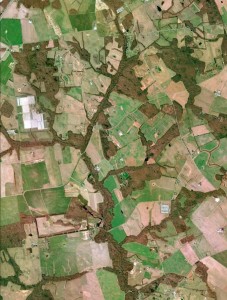
Well-developed riparian forests outline streams and help protect stream water quality.
Most of the time, nutrients are viewed as a positive and essential part of life. However, excess amounts of a nutrient, like nitrogen, can create major ecological problems for the Chesapeake Bay and other aquatic ecosystems. Too much nitrogen leads to an abundance of microscopic plant growth in the water. When the algae die and decay, they consume the oxygen that other organisms need to thrive.
Much of the Bay’s nitrogen pollution comes from farms where rainwater carries nitrate, a form of nitrogen, from fields into streams that drain into the Bay. For years, ecologists have noted that forests and wetlands growing between croplands and streams can reduce the amount of nitrate that reaches the waterways. Scientists have measured nitrate removal by these “riparian buffers,” but only in small study areas.
Click to continue »
Posted in Land Use, Publications, Water Quality | Comments Off on Smithsonian Study Measures Watershed-wide Effects of Riparian Buffers on Nutrient Pollution
Tags: agriculture, Chesapeake Bay, fertilizer, nutrient pollution, riparian buffers, stormwater runoff
Wednesday, June 30th, 2010
Scientists Find Excess Nitrogen Favors Plants That Respond Poorly to Rising CO2
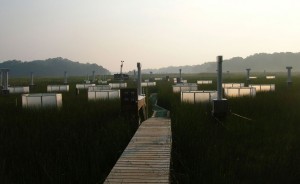
The Smithsonian's Global Change Research Wetland. Photo: SERC
As atmospheric carbon dioxide levels rise, so does the pressure on the plant kingdom. The hope among policymakers, scientists and concerned citizens is that plants will absorb some of the extra CO2 and mitigate the impacts of climate change. For a few decades now, researchers have hypothesized about one major roadblock: nitrogen.
Plants build their tissue primarily with the CO2 they take up from the atmosphere. The more they get, the faster they tend to grow—a phenomenon known as the “CO2 fertilization effect.” However, plants that photosynthesize greater amounts of CO2 will also need higher doses of other key building blocks, especially nitrogen. The general consensus has been that if plants get more nitrogen, there will be a larger CO2 fertilization effect. Not necessarily so, says a new paper published in the July 1 issue of Nature.
Click to continue »
Posted in Climate Change, Ecology, Publications | 2 Responses »
Tags: nitrogen pollution
Thursday, June 24th, 2010
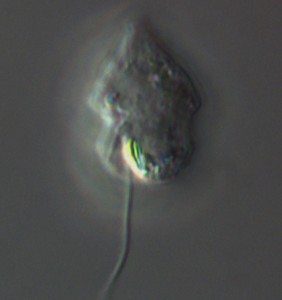
A Tintinnophagus acutus dinospore, with a flagellum. Photo: Wayne Coats
In the microscopic world of marine protists, many species drift in the ocean currents unstudied and nameless. This is no longer the case for the parasitic dinoflagellate
Tintinnophagus acutus. SERC plankton ecologist
Wayne Coats recently finished an extensive description of the organism and thus earned naming rights.
Of the approximately 2,000 known species of living dinoflagellates, about 150 are parasitic. These organisms can alter the marine food web, in some cases destroying prey that consumers like copepods and larval fish rely upon. Coats first spotted T. acutus in the 1980s, in plankton samples he had collected from the Chesapeake Bay. Through his microscope, he noticed a ciliate being edged out of its lorica (shell) by a dinoflagellate. It looked different from others he had observed.
Click to continue »
Posted in Ecology, Publications | Comments Off on Introducing Tintinnophagus acutus
Tags: parasitic dinoflagellates
Thursday, May 27th, 2010
If you’re designing an ambitious field experiment that involves more than 3,800 plants and 240 deer cages, ecologist John Parker has some words of wisdom for you: beware of the unexpected. Beware of meadow voles. Parker is a senior scientist at the Smithsonian Environmental Research Center, in Edgewater, Maryland. He studies the relationship between plants and the herbivores that eat them.
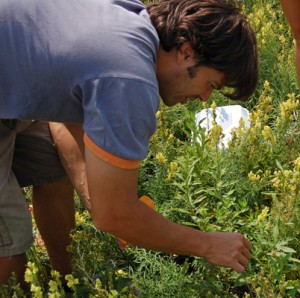
Ecologist John Parker examines one of his plants in the field. Photo: Alex Smith
In a recent paper published in Ecology Letters, Parker chronicles the ups, downs and findings of a study investigating the links between genetic diversity in plants and herbivory. “Most people think about biodiversity in terms of species diversity, where you have a rich variety of plants and animals living in an ecosystem,” explains Parker. “I’m interested in exploring the importance of genetic diversity within a species.” Scientists have recently discovered that plants can benefit from growing in genetically-rich polycultures, where neighboring plants of the same species have different genotypes. Parker’s new research shows that these benefits include better protection against hungry herbivores like deer and voles.
Click to continue »
Posted in Ecology, Publications | 1 Response »
Tags: genetic diversity
Thursday, May 6th, 2010

The woolly bear caterpillar (Pyrrharctia isabella) is a generalist herbivore; it feeds on many of the trees and plants in the woods surrounding SERC. Photo: John Parker
Unless you are a famished hiker on the Appalachian Trail, chances are you have not given much thought to how the forest tastes. Plant flavor is an important area of study for ecologists examining invasive plants. A common theory holds that the success of kudzu and other exotic species is due to foreign biochemistry that makes them repugnant to native herbivores. In a new study published in PLoS ONE, scientists at the Smithsonian Environmental Research Center in Edgewater, Md., have cast doubt on this popular but little-tested idea.
Click to continue »
Posted in Ecology, Invasive Species, Publications | 3 Responses »
Tags: herbivores, plants











